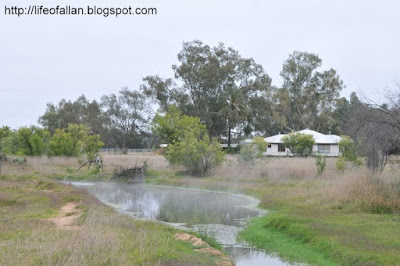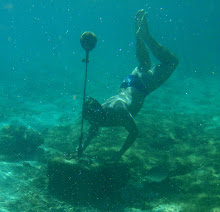
Another big day at Bowra and what a day! :-) After a great sleep I crawled out of the tent as the sun started rising and I was greeted by the local Chestnut-crowned Babbler family dancing around my tent looking for food. My plan for the day was pretty similar to what I had been doing the day before, but benefiting from being significantly more rested and alert I expected another cracker of a day exploring the south-western outback of Queensland.

Our little "Bore-drain-walk"-team was once again ready for a wander along the drainage canal and as the day before I was in for some of the most intense and varied birding I have ever experienced in Australia.

Most of the birds from the day before were still around. Spotted Bowerbird was jumping around in the trees and we once again found the White-winged Fairy-wren in its bush - this time it seemed to be much more relaxed with the attention and I managed to get in close and snap a few photos.

A newcomer this early morning was the Snake-necked Turtle Chelodina longicollis above. Notice how the turtle has hidden its long neck and head by folding it horizontally under the front edge of the carapace, all fresh water turtles in Australia (except for the Pig-nosed Turtle) do this, hence called 'side-necked' turtles. This is different from e.g. the American species that will pull their head straight in when threatened. Another feature of this great little creature is that if you pick it up it will "release a pungent fluid" that will keep you reminded of your wrongdoing for at least a few hours :-D .. it wasn't me ;-)

Birdlife was once again absolutely stunning! Woodswallows, Honeyeaters, Friarbirds - just to get an idea, in less than 50 meter we saw 3 type of parrots; Australian Ringneck, Blue Bonnet and Bourke's Parrot. I was very happy to finally get a photo of Bourke's P., I have seen it once before, but did not manage to get the snap-box pointed in the right direction in time. The Blue Bonnet is another bird I have only seen once before - actually I saw both of these great parrots first time during my trip to Mungo National Park Easter 2009, one of the very first blog posts here on Life of Allan.


No Bowerbird without a bower! After our morning stroll, the caretakers at Bowra had promised to show us the bower of the Spotted Bowerbird. Maybe the Satin Bowerbird makes a "nicer" bower by being so selective in its choice of color, but no doubt that the Spotted Bowerbird had put a lot of hard work into decorating its love nest. Apparently it is not the work of a single male bird, but instead a little gang of boys keeping the bower spotless. All the attention attracted one of the owners and I finally managed to get a decent photo of this species.


Another outback specialty that I have seen before, but not been able to capture well is the Red-backed Kingfisher. But it is all easy around the homestead at Bowra, the birds are used to the attention and will happily strut their feathers. My feeling is that it was significantly harder getting close to birds out in the landscape away from the homestead though, out there humans are rare and the birds much more wary.

However, there were still a few of those "wary" birds that I would not mind seeing and as usual if you are after a specific bird you odds of success are significantly increased by going to its habitat. So the Magna and yours truly once again challenged the red dirt tracks of Bowra.


Midday early summer in outback Australia is not prime birding conditions, but as evident from my earlier dragon post it is near perfect conditions for a bit of reptile spotting. Also I spotted some Mulga Ant nests, Polyrhachis macropa. I have always thought that their easily recognizable rim structure was made to protect the nest from flooding after heavy rain, that is probably right, but there might be even more advantages from this feature - like using the funnel to trap moisture during cold night etc. Read here and see a nest significantly larger than the one in my photo here - The quite large difference in size have actually made me wonder if the ants responsible for the nest in my photos are indeed the same species that is capable of making these enormous craters .. any suggestions are as always welcome.

Midday seems to be prime time for getting your predator in flight photos. The Whistling Kite above was as curious as the Square-tailed Kite had been the day before, but as discussed in that post, you do not always get the same quality even though conditions seems identical. The Whistling Kite photos are fair and easily good enough for the resolution of a blog post, but they lack the sharpness I managed to get the day before. Maybe a tiny variation in the light available - a third of a stop - pushed shutter speed just outside of what I could handhold that day(?)


I do not know if it was from having been in the sun for one and a half day or what, but apparently I managed to direct some of my attention towards the ground. Exploring Australia I have often seen the perfect cylindrical holes that tells you that there are spiders under ground. Once and a while you can be lucky to spot an inhabitant sitting deep down in the shadow of the hole, but so far I have never been able to get good photos before the spider retreated out of flash range. The little cute feller above displayed a very different behavior and I was very happy to record a solid series of shots of the spider sitting high in its tunnel observing the shenanigans above.


Again local knowledge proved priceless! We had managed to convince one of the Bowra caretakers to come along for another trip up to the area of the Hall's Babblers. On the way there we were having a little stop looking for the Chestnut-breasted Quail-thrush when suddenly a little blob in the top of a tree ca. 50 meters away was identified as a Pied Honeyeater :-) I have seen the Pied Honeyeater before in Gluepot SA, but I would never have called the scrubby looking PH in the photo above from 50 meters away as being one of the best Australian honeyeaters around - It would have been even better if it had been the Black H. :-)


Another great find was a Brown Falcon on the nest. The larger predators are very careful where they build their nests and it was clear that the mum falcon did not appreciate the attention. We kept our distance, but I was lucky to at least in a few of the photos catch a glimpse of the juvenile offspring taking a look at the world around them.


Another great day at Bowra, the sun was low when we finally made our way up to the escarpment and we managed to find the Hall's Babblers again. The long drive is a small price to pay for the adventures that the outback will deliver - sitting writing this post I cannot help feeling that it will soon be time to leave again :-)

All good - Probably my longest single blog post ever, so thanks for reading along and you can pat yourself on the back for making it all the way. I will try to squeeze the rest of the trip into a final large Bowra post soon'ish so that I can get onto some of the other stuff that have happened "lately" :-)


4 comments:
Some great birds there, must head out that way soon!
Hi Richard,
Thanks for reading along and for you comment. Yes, Bowra is a fantastic spot - I truly enjoyed my trip there. Going through the pictures and writing about it made me realize that I will soon have to go again :-)
I took a look at your blog - really interesting - I hope it is alright if I add you to my list of blogs I follow(?)
Cheers Allan
Some very good wildlife there and at least a few new ones for me. I might have to drag the family up there mid year.
Hi Jarrod,
I am sure the entire family will love it :-) With Claire doing her first outback trip it might be convenient to stay in the Shearer's quarters, if you do not have to bring the tent there will be more space for diapers in the Mazda :-D
Cheers Allan
Post a Comment